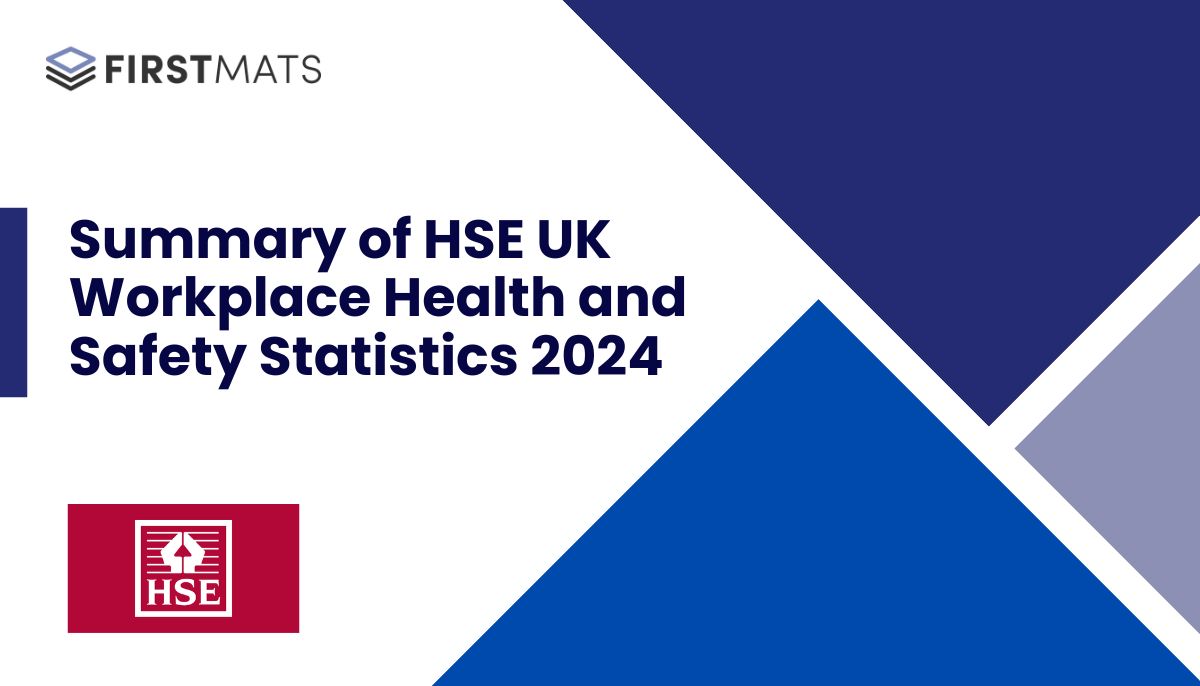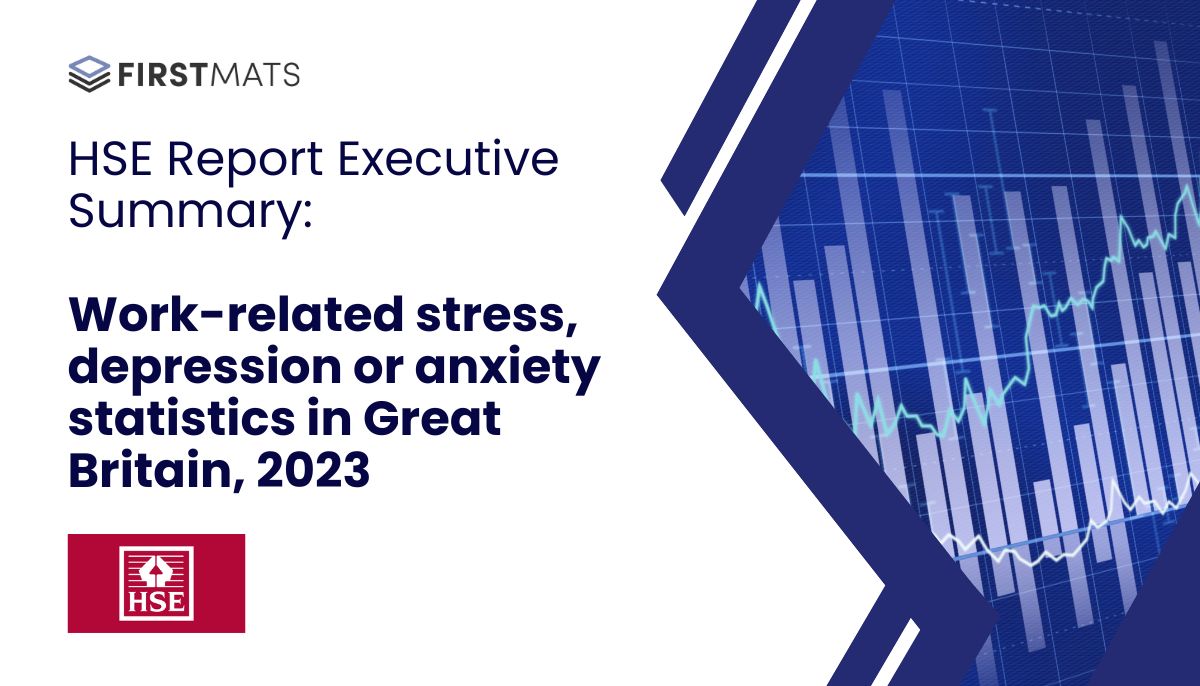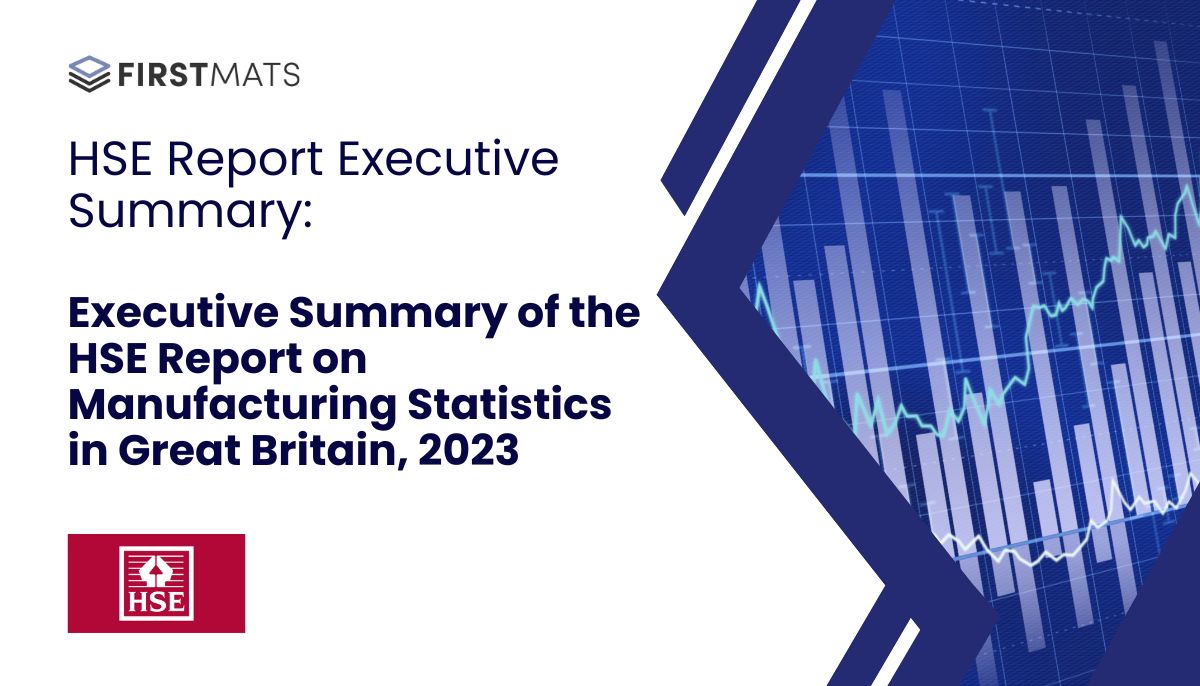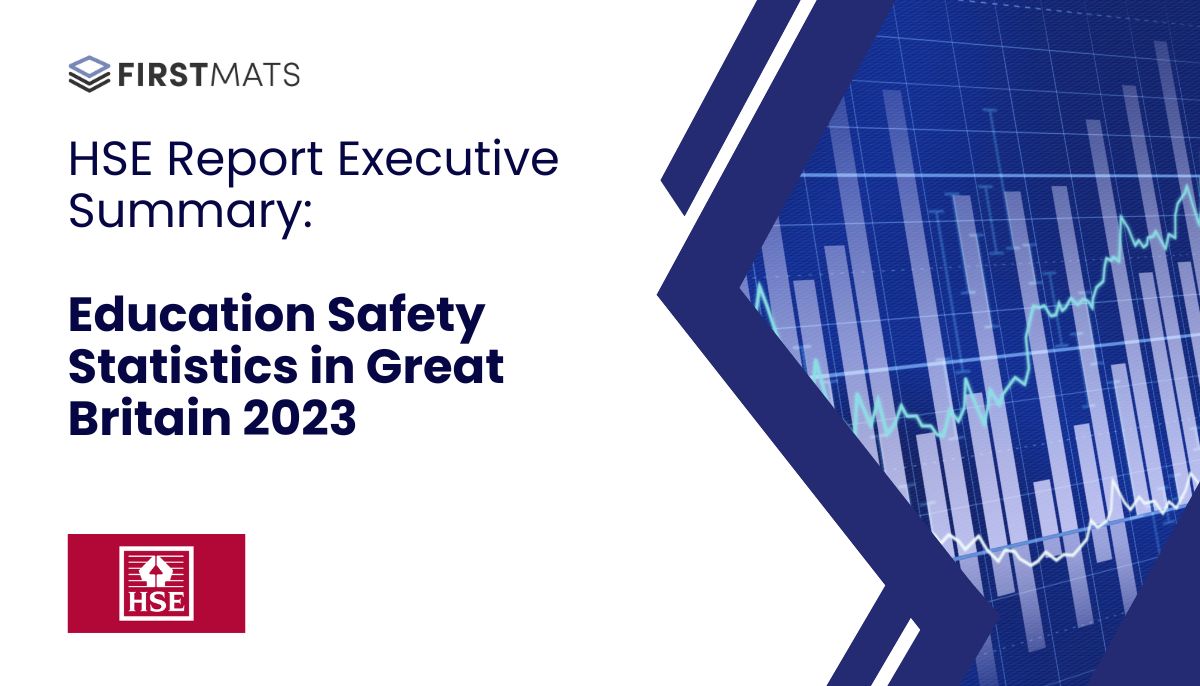
Construction Industry Safety Statistics in Great Britain: HSE Executive Summary
This article, presented by First Mats, is an executive summary of the latest Construction statistics in Great...

Summary of UK Workplace Health and Safety Statistics 2024
Summary of HSE Report: Workplace Health and Safety Statistics 2024 This article summarises the key findings from the Health and Safety Executive (HSE) report, highlighting trends in work-related ill health...

Rubber Sheet Glossary of Terms
Welcome to the First Mats glossary on Rubber Sheet, your detailed resource for understanding the various terms and concepts associated with rubber sheeting, particularly those used...

Rubber Matting Glossary of Terms
Welcome to the First Mats glossary on Rubber Matting, your comprehensive guide to understanding the various terms and concepts related to rubber matting. As a leading provider of high-quality rubber...

Wet Area Matting Terms Glossary
Welcome to the First Mats glossary on Wet Area Matting, a complete resource for understanding the various terms and concepts associated with matting in wet environments. As a leading provider...

Spill Containment Bunds and Pallets Glossary
Welcome to the First Mats glossary on Spill Containment Pallets and Bunds, your comprehensive resource for understanding the various terms and concepts related to spill containment in industrial settings. As...

Industrial Storage Cabinets Glossary
Industrial cabinets are essential for maintaining an organised and efficient workplace, offering secure storage for tools, equipment, and hazardous substances. Our glossary is designed to provide you with clear and...

Entrance Matting Glossary
Welcome to the First Mats glossary on Entrance Mats, your comprehensive resource for understanding the various terms and concepts related to commercial entrance matting. As a leading provider of high-quality...

Anti-Fatigue Mats Glossary
Welcome to the First Mats glossary on Anti-Fatigue Mats, your comprehensive resource for understanding the various terms and concepts related to industrial anti-fatigue matting. As a leading provider of high-quality...

Executive Summary of HSE Workplace Stress Anxiety and Depression Statistics
Executive Summary of the HSE Report on Work-related Stress, Depression or Anxiety Statistics in Great Britain This blog article is a summary of the key findings from the

Executive Summary of HSE Manufacturing Industry Safety Statistics
Executive Summary of the HSE Report on Manufacturing Statistics in Great Britain This blog post by First Mats provides an executive summary of the Read More

Executive Summary of Education Industry Safety Statistics
Executive Summary of the HSE Report: Education Statistics in Great Britain This summary presented by First Mats, is an easy-to-understand overview of the

AquaProtect Mat Restores Clean, Dry Waiting Area for Hogg MOT
Problem In the waiting area of Hogg MOT, the flooring was becoming soaked and dirt built up quickly due to high foot traffic...

Garage Flooring Protected with Pro‑Gym Interlocking Gym Mat Tiles
Problem Dick needed to cover a bespoke space in his personal garage so he could place a Peloton exercise bike there whilst protecting...

IBC Bunds: Delivered Fast for Glastonbury 2025 Event
Problem Emily Allman from Glastonbury Festivals reached out to First Mats with an urgent requirement for several Double IBC Bund Pallets with Removable...

How Anti-Fatigue Mats Are Boosting Operator Comfort and Safety
Problem At Revolution Milling, workshop safety and staff comfort are top priorities, especially in high-use areas like those around the CNC machines. Machine...

Profile Developments: Improving Safety and Style at the Office Entrance
Problem Mark noticed an ongoing issue at the main entrance to Profile Developments’ office. With a high volume of daily foot traffic, especially...

Golden Sands Holiday Park Enhances Safety and Comfort in Pool Changing Areas
Problem Darren, from Golden Sands Holiday Park, reached out following a refurbishment of the site's swimming pool and changing room facilities. Although non-slip...

Portable Bunding for Northern Industrial Battery Services
Problem Gareth, representing Northern Industrial Battery Services Ltd, faced a complex challenge during their company relocation. He required a reliable...

Broccoli Cafe Enhances Entrance with Custom Logo Mat
Problem Broccoli Cafe, a stylish establishment in London, sought to enhance its main entrance with a mat that not only fit the unique...

How We Designed and Delivered 300 Logo Mats to Metro Plumb
The Challenge Metro Plumb, a prominent plumbing services provider, sought to enhance its brand visibility and improve the working conditions of its plumbing team using

St George's School Achieves Cleaner, Safer Entrances
Problem John, the Site Facilities Manager at St George’s School, faced ongoing challenges with dirt and debris being consistently tracked...

Prestbury Bowling Club Upgrade
Problem When Christine was tasked with refurbishing Prestbury Bowling Club, her primary goal was maintaining a safe, welcoming environment, especially...

Prestbury Bowling Club Refurbishment
Problem When Christine was assigned to refurbish Prestbury Bowling Club, her main objective was to maintain a safe and welcoming...

Precision Under Pressure: Crafting Premium Logo Mats for AutoCraft's Big Event
The Problem AutoCraft Motor Caravans, known for their bespoke motor caravan conversions, was gearing up for a significant appearance at the Yorkshire Motorhome and Campervan...

Rapid Response: How First Mats Delivered 524 Premium Logo Mats on Time
Problem In the competitive world of marketing and retail, visual impact is everything. Source Marketing and Retail, a trade customer...

First Mats Supplies Flyball Matting to the Clyde Warriors Flyball Team
The Clyde Warriors Flyball team is a competitive flyball team based in Lanark, Scotland. Flyball is a dog sport in which teams of dogs race against each other over...

How First Mats Helped Junkyard Dogs with Their Flyball Competition
If you're a dog trainer or Flyball competitor, then you know that having the right matting is essential for providing a safe and comfortable space for your dogs. That's why...

How First Mats Helped Bracknell Swimarium with Their Flooring Refurbishment
Recently, we were approached by Bracknell Swimarium, who required a large amount of our Aqua-Deck PVC Wet Room Mat Tiles for their pool area. However, they needed the tiles fast—in less...

Which Mats Should Be Used in Data Centres?
Data centres have a very different relationship with floor matting than most workplaces. A typical entrance mat is built to scrape off grit and soak up rainwater so floors stay...

The Best Floor Mats for Packing Stations
Packing stations are often the heartbeat of goods-out. If your team is picking, checking, boxing, labelling, and getting orders ready for collection, they’re likely spending long periods on hard floors,...

The Best Mats for Schools, Universities, and Other Education Institutes
Schools, colleges, universities, and academies all have one thing in common: high footfall. From pupils rushing between lessons to staff, visitors, and parents coming and going throughout the day, education...

The Best Types of Floor Mats for Shops & Retail Environments
Retail entrances work harder than almost any other area of a building. Every customer that walks through the door brings moisture, dirt, grit, and debris with them, all of which...

Best Mats for Campsites and Holiday Parks
If you run a campsite or holiday park, you already know the pattern: one wet weekend and suddenly the reception floor is gritty, the route to the wash block is...

DDA-Compliant Floor Matting: What to Choose (and Avoid) for Accessible Entrances
Contents The DDA and accessibility duties Why there’s no such thing as “certified DDA-compliant” matting The legal frameworks that affect matting choices What...

The Best Floor Mats for Stock Rooms and Store Rooms
Stock rooms and store rooms are often busy, functional spaces that support the smooth running of retail, hospitality, food service and commercial environments. While they may not be customer-facing, these...

Choosing the Best Mats for Farmhouses
Farmhouses are some of the most characterful and welcoming homes in the UK, but they also face flooring challenges that most modern properties rarely encounter. Muddy fields, gravel paths, farm...

Floor Mats Guide for Housing Associations and HMOs
Housing associations, HMO landlords, and property managers oversee buildings where multiple residents share entrances, corridors, and communal facilities. These high-use areas experience significant foot traffic, frequent cleaning demands, and a...

Choosing the Right Mats for Leisure Centres
Leisure centres are dynamic environments where hundreds of visitors pass through each day. From swimming pools and changing rooms to gyms and entrance lobbies, each area presents its own challenges...

The Best Floor Mats for Builders: A Practical Guide for Professionals
Builders and tradespeople work in environments that can shift dramatically from one moment to the next. A single job may involve muddy outdoor areas, unfinished interiors, delicate flooring, and spaces...

Best Floor Mats for Waste Management and Recycling Centres
Waste management and recycling centres operate in some of the most demanding environments of any industry. Constant foot traffic, exposure to liquids and debris, and the presence of oils, chemicals,...

Break Room Mats for Cleaner, Safer Staff Areas
A staff break room is more than just a place to grab a quick coffee. It is a vital welfare space where employees unwind, reset, and return to work feeling...

The Best Floor Mats for Property Developers
Property developers have very different needs from the average homeowner when it comes to floor mats. While a typical domestic doormat only needs to cope with light foot traffic, property...

How to Keep Your Site Cabin Floors Clean
Keeping a site cabin clean may not be the first thing on a busy site manager’s checklist, but it plays a major role in maintaining a safe, organised, and compliant...

Portable Containment Bund - Compatibility Chart
Selecting suitable equipment for chemical storage and spill control depends on verified material compatibility. This guide summarises how common substances interact with PVC with a protective proofing layer (PES/PVC), enabling...

Colorful Classrooms: Leveraging Floor Matting and Adjustable Furniture to Create Engaging Spaces
Learning environments are evolving to meet the needs of students who think, move, and learn differently. Colourful classroom spaces that combine thoughtful design with vibrant visual elements are more than...

Entrance Mat Sizing Guide
Have you ever purchased a mat only to find it's too small to catch dirt or too large for your doorway? Selecting the right-sized mat is essential, not just for...

What Are the Most Eco-Friendly Floor Mats?
Have you ever paused at your front door and wondered if your doormat is eco-friendly? We often focus on recycling and reducing energy use in our homes, but even a...

Which Floor Mats Can You Use Outdoors?
Have you ever stepped outside your door and slipped on a wet, ineffective mat? Or perhaps you've noticed your once-attractive mat has deteriorated rapidly after being exposed to rain and...

How to Fit a Recessed Door Mat
Recessed door mats keep your entryway tidy and safe by fitting flush with your floor. If you have an existing matwell or frame, installing coir...
Frequently Asked Questions
If you have any questions, we’re here to help
How long does delivery take?
Each product comes with a specified lead time for delivery. We'll keep you informed if there are any delays in meeting this timeline.
Typically, once you’ve finalised your order and approved the proof, it will take 4-5 business days to make and deliver your finished mat.
If my order is damaged, can I return or exchange it?
Got a problem with your order? If something's not right or you're not thrilled with the quality, just let us know within 14 days of getting it. Drop us a line, and we'll tell you what to do next—usually, it starts with you sending us a photo of the issue. Once we check that out, we'll sort you out with a refund or a new item, no fuss.
Can I get my mat delivered more quickly?
Need your item in a hurry? Just Contact us to explore the faster delivery options we might have for you!
If my custom mat is damaged, can I return or exchange it?
Got a problem with your order? If something's not right or you're not thrilled with the quality, just let us know within 14 days of getting it. Drop us a line, and we'll tell you what to do next—usually, it starts with you sending us a photo of the issue. Once we check that out, we'll sort you out with a refund or a new item, no fuss.






